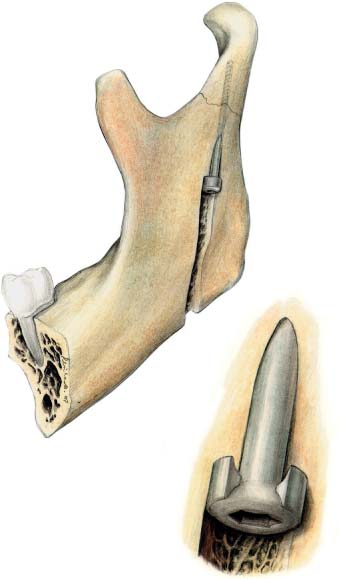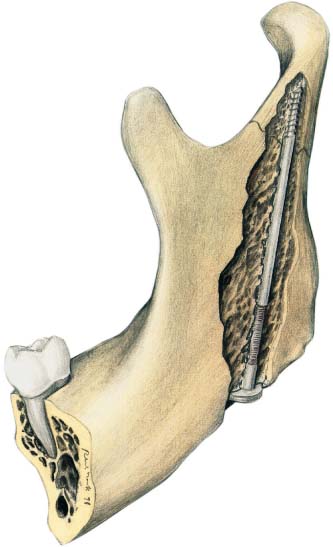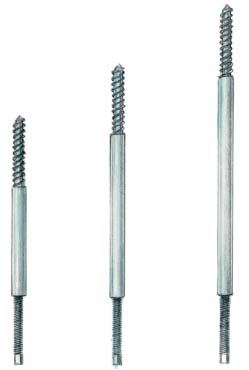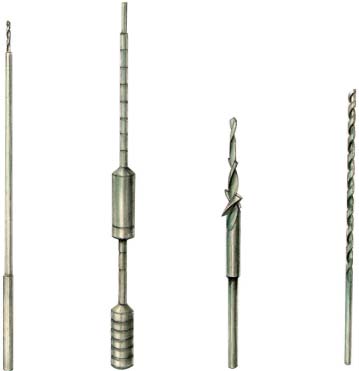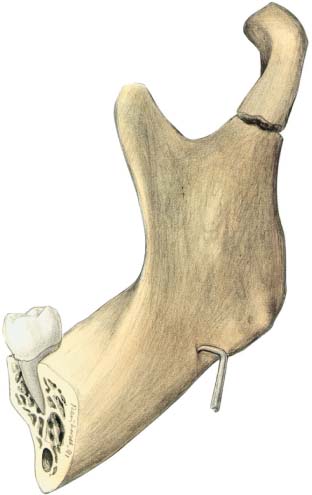12 Condylar Neck Fractures: Lag Screws The primary aim of the treatment of condylar neck fractures is the restoration of an undisturbed functionality to the temporomandibular joint. One method is lag screw osteosynthesis (see Chapter 9), which is used for achieving a stable fixation of the fragments, primary bone healing, and early mobilization to restore the functions of the joint. Wackerbauer (1962) and Petzel (1980) first described a method of performing lag screw osteosynthesis of condylar neck fractures via a submandibular approach, using long lag screws. An intraoral lag screw method was described by Kitayama in 1989. Krenkel (Krenkel and Lixl, 1988; Krenkel, 1992) developed a method of lag screw osteosynthesis of condylar neck fractures by a submandibular approach, using a lag screw with a biconcave anchor washer to prevent microfractures (Fig. 12.1). Kuttner (1989) has demonstrated that lag screws with biconcave washers (anchor washers) can be turned twice as tightly as screws without washers before cracks occur in the bone. Eckelt (Eckelt and Gerber 1981; Eckelt, 1984) developed a special nut and screw for lag screw osteosynthesis of condylar neck fractures via a special surgical periangular approach (Fig. 12.2). This method has been especially developed to remove the osteosynthesis materials without reopening the joint region, which poses a further risk of facial nerve lesions. Fig. 12.1 Principle of lag screw osteosynthesis according to Krenkel, at the condylar neck of the mandible. Use of this technique is indicated in condylar base and neck fractures: • with dislocation • with significant displacement of more than 10° or contraction of the fragments by more than 2 mm or lack of bone contact in the fragments Special surgical instruments have been developed for secure execution of lag screw osteosynthesis. These include lag screws with diameters of 2 mm and 2.3 mm. The latter is used as an emergency screw only (Fig. 12.3). The lag screws are 45–70 mm in length, in increments of 5 mm. The screws have a cortical thread of 10 mm at one end and a metric machine thread at the other. At this end is a square head which fits a special square spanner for insertion of the screws (Fig. 12.4). Interfragment pressure is caused by screwing a nut onto the lag screw at the mandibular base. The nut has a sleeve 6 mm long, projecting into the gliding channel, and is fitted against the base of the mandible (Fig. 12.5). Fig. 12.2 Principle of lag screw osteosynthesis according to Eckelt, at the condylar neck of the mandible. Fig. 12.3 Range of lag screws. Fig. 12.4 Square spanner suitable for the lag screw. Fig. 12.5 Nut and special spanner. Fig. 12.6 Condylar drill, depth gauge, countersink, and twist drill. Fig. 12.7 The mandible is pulled down with a single-forked hook to facilitate reduction of the condylar fragment.
Introduction
Indication
Instruments
Stay updated, free articles. Join our Telegram channel

Full access? Get Clinical Tree


